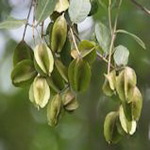| Medicinal Uses: |
Stimulant, tonic, astringent, hemorrhages, diarrhea, dysentery, edema, skin problems, fractures, it is also antibacterial and antimutagenic. |
| Evidence of Benefit: |
Arjuna is among the most frequently prescribed herbs for cardiovascular health in Ayurvedic medicine. The bark of the arjuna tree contains calcium salts, magnesium salts, tannins, and glucosides. It is a stimulant, tonic, and astringent and is used to treat hemorrhages, diarrhea, dysentery, edema, skin problems, and fractures. In addition, it has been found to have antibacterial and antimutagenic properties.
Benefits of arjuna for specific health conditions include the following:
- Angina, Congestive Heart Failure, and Heart Attack: The primary benefit of arjuna is improvement of cardiac muscle function and improved pumping activity of the heart. It is thought that the saponin glycosides are the reason for the beneficial effects of arjuna. The flavonoids and oligomeric proanthocyanidins (OPCs) it contains help to strengthen blood vessels and have antioxidant activity. Arjuna is used as a heart tonic to treat heart failure and edema, a condition in which fluid accumulates in the ankles and legs because the heart is not circulating blood properly. In a three-month study of angina patients who took arjuna, Indian physicians tracked a number of health indicators, including blood pressure, high-density lipoprotien (HDL, or "good") cholesterol, and frequency of angina attacks. Overall, there was a 50 percent reduction in the frequency of attacks, with lower systolic blood pressure and slightly increased HDL cholesterol levels. The more unstable the angina, however, the less arjuna helped the condition in the first three months of treatment. However, a double-blind study over a period of twenty-four months led to reduced symptoms, increased mobility, and patient reports of increased quality of life. Using arjuna regularly for one year can strengthen the heart to its best condition.
- Gonorrhea: Researcher at Arizona State University has confirmed that one of the bioavailable chemical constituents of arjuna, luteolin, acts against Neisseria gonorrhoeae, the bacterium that cause gonorrhea. This effect may also help explain arjuna's usefulness in treating heart disease, since a related microorganism, chlamydia, may be involved in the process of artherosclerosis.
|

